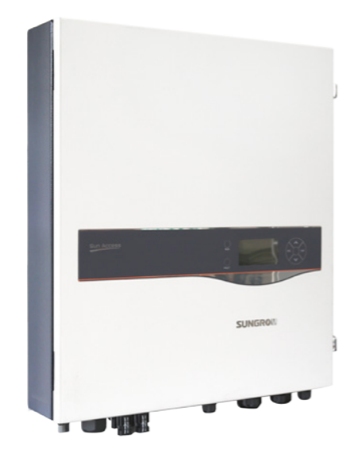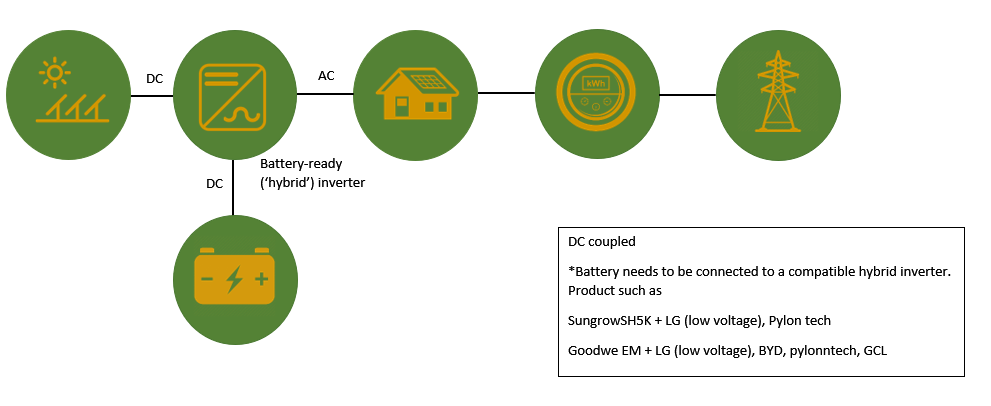As more and more Australian households investigate (and install) solar battery storage, the more we get questions about battery-ready or hybrid solar & battery storage systems. What is a hybrid/battery-ready solar system – and is one right for your home?
Important note: This article focuses on grid-connected solar systems, but some of the technologies discussed may also be appropriate for off-grid/stand alone systems.
Hybrid vs ‘battery-ready’ solar systems: What’s the difference?
The terms ‘hybrid’ and ‘battery-ready’ are thrown around as if they mean the same thing – and in fact, neither term has a strict technical definition in Australia. Instead, both are informally used to describe home solar systems that handle both solar panels and batteries.
That being said, ‘hybrid’ has the connotation (and history) of being capable of both on-grid/off-grid functionality, while ‘battery-ready’ tends to be used in sales-speak to describe a solar system which is suitable for the addition of battery storage at a later date. A solar system (without batteries) that is sold as being ‘battery-ready’ will usually come equipped with a hybrid inverter – or slightly more technically speaking, a grid-connect inverter that can handle both solar & batteries (see section below about ‘types of hybrid inverters’).
Example of how a battery-ready/hybrid inverter fits into a home solar system.
Compare Solar & Battery Quotes
Are you looking at a battery-ready solar system for a future battery add-on?
Guess what? Virtually all solar systems are ‘battery compatible’!
But read the fine print!
Here’s one of the most important tips we can give you if you’re considering batteries for your home: You do not need your system to be ‘battery ready’ when you purchase it in order to add batteries in the future. That’s because batteries can be added onto any existing solar PV system as long as they have their own connection to the AC mains grid. The trick is that connecting your batteries (which store DC electricity) to the AC mains may require a second inverter – a second ‘box’ that you have to pay for. So really, the main advantage of getting a truly ‘battery-ready’ solar system is that when the time comes to add batteries, you can plug them directly into your existing inverter, without any additional equipment or associated costs.
But make sure that the system you are going to purchase is truly ready for batteries (discussed in more detail below). If you’re looking to purchase a battery-ready solar system now with the intention of making it easier when you decide to add batteries in the next few years, the main questions to ask the salesperson are:
- When you add batteries in the future, will you be able to plug them directly into the existing inverter?
- Is there any additional equipment (besides cabling) that will need to be purchased and installed in addition to the batteries themselves when the time comes to get storage?
- What types and brands of batteries will be compatible with your inverter?
- (N.b. that this is a tricky question as battery technology is changing. In most cases, you’ll want to know that the inverter will be able to accommodate the most popular brands of lithium batteries, which currently include LG Chem, Samsung, Pylontech, BYD and a handful of others but which may expand in the near future. Also be clear that going with an ‘all in one’ product in the future – such as Tesla’s Powerwall 2 – would mean that there was no point in having a battery-ready inverter in the first place, as these types of products have inverters built into them.)
If you don’t trust the sales person (begging the question of why you’d buy solar from someone you don’t trust), it’s also look up the inverter model on the Clean Energy Council’s list of accredited inverters – just to make sure you’re getting exactly what you think you’re getting.
Are you looking at solar battery storage now?
Know your options – One box or two?
When it comes to attaching batteries to residential solar systems, there are a few different technological approaches that exist. To oversimplify things a bit, in a nutshell, you can have a ‘one box’ solution, (where a central string inverter handles both solar & batteries), or you can have a ‘two box’ solution’ (where both solar & batteries have their own, separate inverters).
If you’re in the market for a brand new solar-plus-storage system right now, the easiest and most cost-effective approach is to get a system with an inverter that simultaneously handles both your solar panels and your battery bank (a ‘one box’ solution). That’s what we’e focus on in this article.
If you’re looking at a battery retrofit for an existing solar system, on the other hand, you’re probably (but not necessarily) looking at a two-box solution – you’ll want to check out this helper tool.
Types of hybrid inverters: Know the difference
Inverters that ‘do’ both solar as well as batteries are generally referred to informally as ‘hybrid inverters’ or ‘battery-ready’ inverters. Strictly speaking, however, there are three categories of solar+battery inverters as approved by the Clean Energy Council (which accredits solar products for the Australian market), and what distinguishes them is how they handle backup power.
- Grid Connected Inverter (PV and Battery) – No blackout protection
- Grid-connected inverters that do not provide multi-mode functions (see below) – which basically means that it does not provide backup protection functionality if the grid goes down (i.e. if there’s a blackout, your solar & batteries aren’t going to keep the lights on for you)
- Multiple Mode Inverter (PV and Battery) – Blackout protection with a short delay
- Grid-connected inverters that ‘operate in more than one mode’ – namely ‘grid-connected’ and ‘stand alone’ modes; these types of inverters allow either a) your entire home or b) a dedicated circuit in your home to keep running in the event of a blackout – although it may take a few seconds for the backup functionality to ‘kick in’ once the grid goes down.
- UPS Multiple Mode Inverter (PV and Battery) – Blackout protection that comes on instantly
- Grid-connected multi-mode inverters that provide grid-connect and ‘stand alone’ modes, but also with an ‘uninterruptible power supply’ (UPS) – which basically means that in the event of a blackout, you won’t even notice when your inverter switches over into stand alone mode (which it can do in less than 25 microseconds)
Make sure you’re clear on which one you want or need so that you can speak cogently with solar salespeople and know exactly what you’re getting.
Hybrid/battery-ready inverters are not a necessity – but they make things easier
The main advantages of the ‘one box’ approach (as opposed to the ‘two box’ approach) to battery storage are:
- Generally more cost-effective, as you’re only paying for one inverter instead of two;
- Allows you to get a ‘battery ready’ system now (without batteries) for easy future expansion;
- Depending on the brand of inverter & its capabilities, solar & battery monitoring through a single portal (instead of two separate portals/apps);
- In most cases, includes the option for some kind of power backup functionality (in the even of a blackout);
- Enables you to get around network inverter capacity limits more easily than a ‘two box’ solution, which is important because some networks count battery inverters towards total inverter capacity;
- Potentially higher overall system efficiency, as energy is not being converted from DC-AC and then AC-DC again to charge batteries; and
- Fewer parts means less can potentially go wrong, and there are (ideally) fewer component manufacturers to deal with in the event that you do need to file a warranty claim.
How much more do hybrid inverters cost?
A hybrid inverter will typically cost between $1,000-$2,000 more than a standard solar PV inverter, depending on the brand and inverter size.
 Who makes battery-ready/hybrid inverters?
Who makes battery-ready/hybrid inverters?
There are over a dozen manufacturers who offer hybrid/battery-ready inverters approved for Australia (again, a complete, searchable list is available on the CEC website). Some of the prominent ones include:
- Alpha-ESS – Energy Storage Inverter series
- Huawei Technologies – SUN2000 series
- sonnen – sonnenBatterie series
- Igeteam – 1 Play series
- Delta Electronics – ES series
- SolaX – X-Hybrid, X3-Hybrid & X3-Fit series
- Redback – Smart Hybrid series
- Fronius – Symo Hybrid series
- GoodWe – EM & ES series
- Selectronic – SP PRO AU series
- SolarEdge – StorEdge series
- Sungrow – Sun Access series (SH5K)
Just make sure that when you decide on a product that you know exactly what you’re getting – and what it’s capable of.
Compare Solar & Battery Quotes
- APsystems Battery Review: An Independent Assessment by Solar Choice - 18 December, 2025
- Running Cost of Air Conditioners – Explained - 7 October, 2025
- Air Conditioner Rebate South Australia: What You Need to Know - 19 September, 2025
